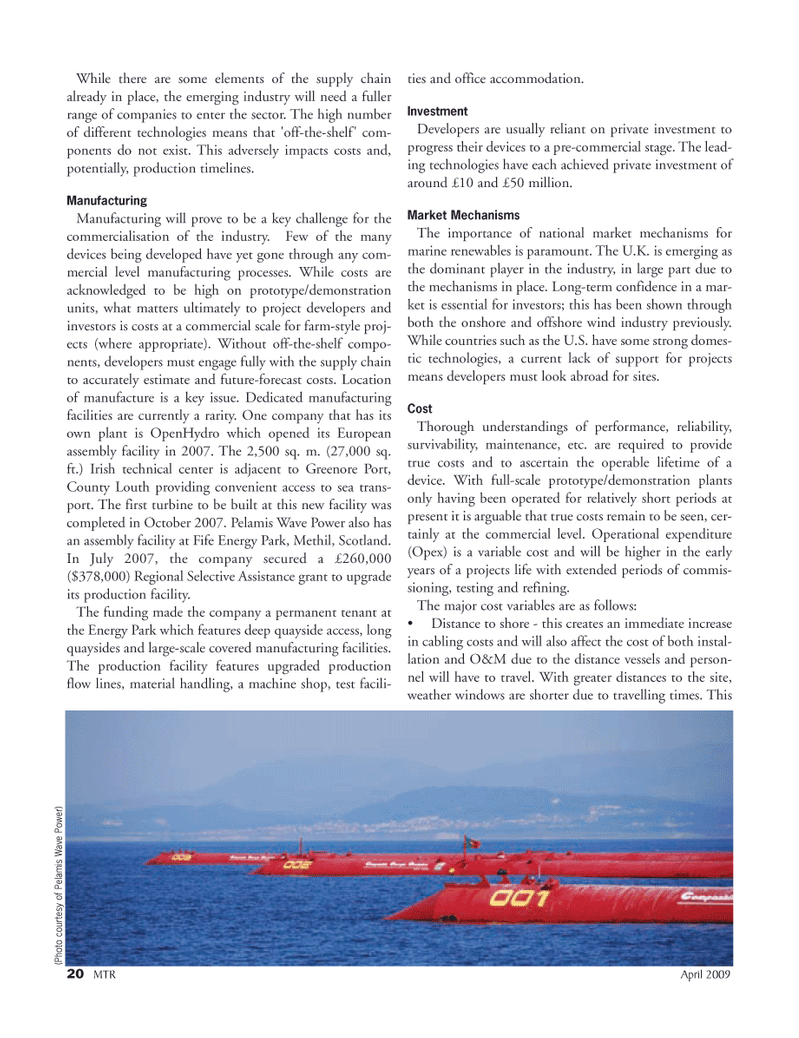
Page 20: of Marine Technology Magazine (April 2005)
Read this page in Pdf, Flash or Html5 edition of April 2005 Marine Technology Magazine
20 MTR April 2009
While there are some elements of the supply chain already in place, the emerging industry will need a fuller range of companies to enter the sector. The high number of different technologies means that 'off-the-shelf' com- ponents do not exist. This adversely impacts costs and, potentially, production timelines.
Manufacturing
Manufacturing will prove to be a key challenge for the commercialisation of the industry. Few of the many devices being developed have yet gone through any com- mercial level manufacturing processes. While costs are acknowledged to be high on prototype/demonstration units, what matters ultimately to project developers and investors is costs at a commercial scale for farm-style proj- ects (where appropriate). Without off-the-shelf compo- nents, developers must engage fully with the supply chain to accurately estimate and future-forecast costs. Location of manufacture is a key issue. Dedicated manufacturing facilities are currently a rarity. One company that has its own plant is OpenHydro which opened its European assembly facility in 2007. The 2,500 sq. m. (27,000 sq. ft.) Irish technical center is adjacent to Greenore Port,
County Louth providing convenient access to sea trans- port. The first turbine to be built at this new facility was completed in October 2007. Pelamis Wave Power also has an assembly facility at Fife Energy Park, Methil, Scotland.
In July 2007, the company secured a £260,000 ($378,000) Regional Selective Assistance grant to upgrade its production facility.
The funding made the company a permanent tenant at the Energy Park which features deep quayside access, long quaysides and large-scale covered manufacturing facilities.
The production facility features upgraded production flow lines, material handling, a machine shop, test facili- ties and office accommodation.
Investment
Developers are usually reliant on private investment to progress their devices to a pre-commercial stage. The lead- ing technologies have each achieved private investment of around £10 and £50 million.
Market Mechanisms
The importance of national market mechanisms for marine renewables is paramount. The U.K. is emerging as the dominant player in the industry, in large part due to the mechanisms in place. Long-term confidence in a mar- ket is essential for investors; this has been shown through both the onshore and offshore wind industry previously.
While countries such as the U.S. have some strong domes- tic technologies, a current lack of support for projects means developers must look abroad for sites.
Cost
Thorough understandings of performance, reliability, survivability, maintenance, etc. are required to provide true costs and to ascertain the operable lifetime of a device. With full-scale prototype/demonstration plants only having been operated for relatively short periods at present it is arguable that true costs remain to be seen, cer- tainly at the commercial level. Operational expenditure (Opex) is a variable cost and will be higher in the early years of a projects life with extended periods of commis- sioning, testing and refining.
The major cost variables are as follows: • Distance to shore - this creates an immediate increase in cabling costs and will also affect the cost of both instal- lation and O&M due to the distance vessels and person- nel will have to travel. With greater distances to the site, weather windows are shorter due to travelling times. This (Photo cour tesy of Pelamis W ave Power)
MTR#3 (18-33).qxd 3/27/2009 1:57 PM Page 20

 19
19

 21
21
